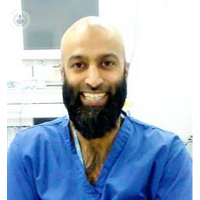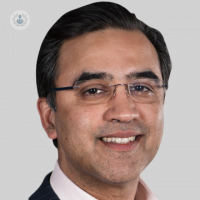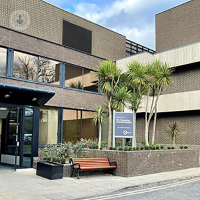What is ACL reconstruction?
The anterior cruciate ligament (ACL) is a band of connective tissue within the knee which, when over-stretched can get damaged and tear. This can happen during exercise, or with a sudden turn or movement. The ACL helps to keep the knee stable, and when it is damaged you are unable to play sports or to walk properly.
Although a damaged ACL can repair over time, if it is badly torn it will require reconstruction. ACL reconstruction surgery replaces the torn ligament with new tissue, and it is usually performed arthroscopically, using specialist tools that are inserted and guided by a camera through very small incisions.

Why would you need ACL reconstruction?
ACL reconstruction surgery will be recommended if the patient has badly torn the ligament, or if the patient is young, active and wishes to continue playing sports and being active. Older, less active patients will often be recommended non-surgical treatments. ACL reconstruction also prevents further, worse damage happening to the knee cartilage.
What does ACL reconstruction involve?
During ACL reconstruction, the torn ligament is removed and replaced with a graft of new tissue. This tissue is taken from the patient’s body, such as the hamstring tendon, or the kneecap tendon (patellar tendon).
Sometimes a donated tendon can be used too. The surgeon will drill two holes, called ‘tunnels’ so that the new tendon can be anchored in place. One ‘tunnel’ will be placed above the knee, and the other below it. With time, a new ACL will grow as the knee heals.
How to prepare for ACL reconstruction
Before surgery, the knee is shaved if necessary, any jewellery is removed and a hospital gown is worn. Anaesthesia for ACL reconstruction can either be regional or general.
Post-operative care
After surgery, you will stay in a recovery room for a few hours, until the anaesthesia has worn off. Afterwards, you can return home and rest. You will be given crutches to help with mobility and to keep pressure off the knee.
Depending on your job, it is possible to return after just one week post-surgery. For more physical jobs, sometimes one to four months rest can be required. Intensive exercise is only recommended 6-8 months after surgery. During recovery, physical therapy exercises will help to restore strength to the affected knee.
03-05-2018 10-18-2023ACL reconstruction
Professor Adrian Wilson - Orthopaedic surgery
Created on: 03-05-2018
Updated on: 10-18-2023
Edited by: Conor Dunworth
What is ACL reconstruction?
The anterior cruciate ligament (ACL) is a band of connective tissue within the knee which, when over-stretched can get damaged and tear. This can happen during exercise, or with a sudden turn or movement. The ACL helps to keep the knee stable, and when it is damaged you are unable to play sports or to walk properly.
Although a damaged ACL can repair over time, if it is badly torn it will require reconstruction. ACL reconstruction surgery replaces the torn ligament with new tissue, and it is usually performed arthroscopically, using specialist tools that are inserted and guided by a camera through very small incisions.

Why would you need ACL reconstruction?
ACL reconstruction surgery will be recommended if the patient has badly torn the ligament, or if the patient is young, active and wishes to continue playing sports and being active. Older, less active patients will often be recommended non-surgical treatments. ACL reconstruction also prevents further, worse damage happening to the knee cartilage.
What does ACL reconstruction involve?
During ACL reconstruction, the torn ligament is removed and replaced with a graft of new tissue. This tissue is taken from the patient’s body, such as the hamstring tendon, or the kneecap tendon (patellar tendon).
Sometimes a donated tendon can be used too. The surgeon will drill two holes, called ‘tunnels’ so that the new tendon can be anchored in place. One ‘tunnel’ will be placed above the knee, and the other below it. With time, a new ACL will grow as the knee heals.
How to prepare for ACL reconstruction
Before surgery, the knee is shaved if necessary, any jewellery is removed and a hospital gown is worn. Anaesthesia for ACL reconstruction can either be regional or general.
Post-operative care
After surgery, you will stay in a recovery room for a few hours, until the anaesthesia has worn off. Afterwards, you can return home and rest. You will be given crutches to help with mobility and to keep pressure off the knee.
Depending on your job, it is possible to return after just one week post-surgery. For more physical jobs, sometimes one to four months rest can be required. Intensive exercise is only recommended 6-8 months after surgery. During recovery, physical therapy exercises will help to restore strength to the affected knee.


ACL injuries in children and adolescents
By Mr Jamie Arbuthnot
2024-11-21
Injuries to the anterior cruciate ligament (ACL) are increasing in children. The reason for this is not clear but it is related to the intensity and frequency at which some children play sports today, the footwear they use and the coaching techniques that are used. Orthopaedic surgeon Mr Jamie Arbuthnot tells us what happens when a young person injures their ACL and what can be done to fix it. See more
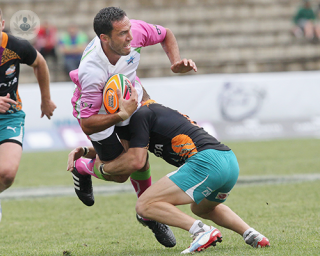

Knee injuries and rugby: advancements in minimally invasive surgery
By Mr Amer Khan
2024-11-21
Advancements in minimally invasive surgery have created faster and less invasive treatment possibilities for knee injuries. Mr Amer Khan, a renowned knee and shoulder surgeon who specialises in sports injuries, explains how this is possible. See more
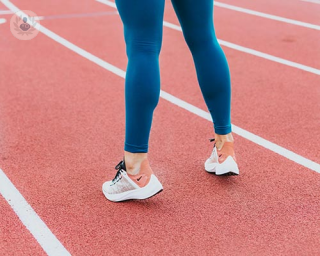

ACL reconstruction explained: surgery, recovery, and expected outcomes
By Mr Ricci Plastow
2024-11-20
ACL reconstruction is a common surgical procedure aimed at restoring stability and function to the knee after an anterior cruciate ligament (ACL) injury. Leading consultant trauma and orthopaedic surgeon Mr Ricci Plastow provides a comprehensive overview of the surgery, detailing the steps involved, the recovery process, and the expected outcomes See more
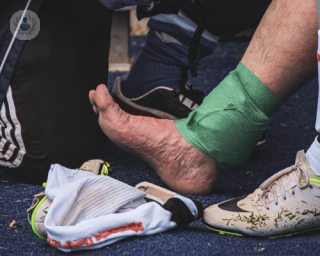

From incident to recovery: A holistic approach to Achilles tendon injuries
By Mr Hisham Shalaby
2024-11-20
Achilles tendon injuries are common, but there are various aspects which make each one different. This encompasses the cause, type of injury and considering the patient’s overall health, as well as the treatment route involved. Leading orthopaedic surgeon Mr Hisham Shalaby considers these important points, while also taking a look at recovery from operative treatment, and what can happen if an Achilles tendon injury goes untreated. See more
Experts in ACL reconstruction
-
Mr Ziali Sivardeen
Orthopaedic surgeryExpert in:
- Shoulder dislocation
- Rotator cuff surgery
- Frozen shoulder
- Elbow arthroscopy
- ACL reconstruction
- Meniscus
-
Mr Arjuna Imbuldeniya
Orthopaedic surgeryExpert in:
- ACL reconstruction
- Anterior cruciate ligament
- Knee arthroscopy
- Sports injuries
- Joint injections
- Hip replacement
-
Mr Fahad Gulam Attar
Orthopaedic surgeryExpert in:
- Knee osteoarthritis
- Stem cells
- Knee cartilage replacement
- Sports injuries
- Knee replacement
- ACL reconstruction
-
Mr Sanjiv Manjure
Orthopaedic surgeryExpert in:
- Sports injuries
- Knee replacement
- ACL reconstruction
- Revision knee replacement
- Hip replacement
- Knee arthroscopy
-
Mr Minhal Chatoo
Orthopaedic surgeryExpert in:
- Osteotomy
- Knee surgery
- ACL reconstruction
- Knee arthroscopy
- Knee replacement
- Sports injuries
- See all

The Clementine Churchill Hospital - part of Circle Health Group
The Clementine Churchill Hospital - part of Circle Health Group
Sudbury Hill, Harrow HA1 3RX
No existe teléfono en el centro.
By using the telephone number provided by TOP DOCTORS, you automatically agree to let us use your phone number for statistical and commercial purposes. For further information, read our Privacy Policy
Top Doctors

The Highfield Hospital - part of Circle Health Group
The Highfield Hospital - part of Circle Health Group
Manchester Road, Rochdale, Lancashire, OL11 4LZ
No existe teléfono en el centro.
By using the telephone number provided by TOP DOCTORS, you automatically agree to let us use your phone number for statistical and commercial purposes. For further information, read our Privacy Policy
Top Doctors

New Victoria Hospital
New Victoria Hospital
184 Coombe Lane West, Kingston upon Thames, KT2 7EG
No existe teléfono en el centro.
By using the telephone number provided by TOP DOCTORS, you automatically agree to let us use your phone number for statistical and commercial purposes. For further information, read our Privacy Policy
Top Doctors
-
The Clementine Churchill Hospital - part of Circle Health Group
Sudbury Hill, Harrow HA1 3RX, West LondonExpert in:
- Abdominal ultrasound
- Abdominoplasty
- Acne
- Allergies bronchopulmonary
- Allergies nose and ears
- Allergy Dermatitis
-
The Highfield Hospital - part of Circle Health Group
Manchester Road, Rochdale, Lancashire, OL11 4LZ , RochdaleExpert in:
- Cardiology
- Orthopaedic surgery
- Plastic surgery, reconstructive and aesthetics
- Dermatology
- Diagnostic Imaging
- Endocrinology
-
New Victoria Hospital
184 Coombe Lane West, Kingston upon Thames, KT2 7EG, South LondonExpert in:
- Cardiology
- General Surgery
- Orthopaedic surgery
- Breast augmentation
- Pain management
- Spine
- See all
- Most viewed diseases, medical tests, and treatments
- Joint pain
- Lumbar herniated disc
- Spinal surgery
- Minimal access surgery (keyhole surgery)
- Shoulder pain
- Osteoporosis
- Botulinum toxin (Botox™)
- Abnormal gait
- Shoulder osteoarthritis
- DEXA scan

